"..the picture or figure is in itself the body,
whereas its signification is the soul of the image.."
whereas its signification is the soul of the image.."
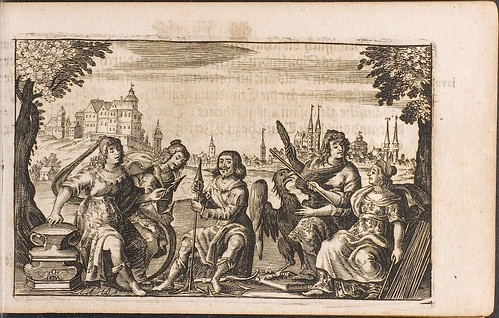

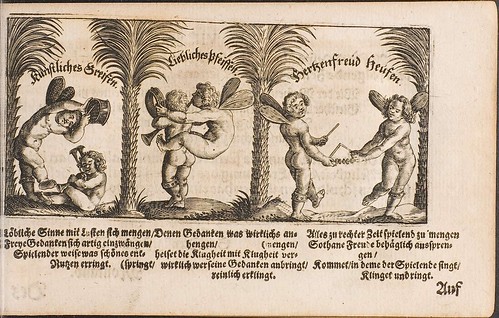
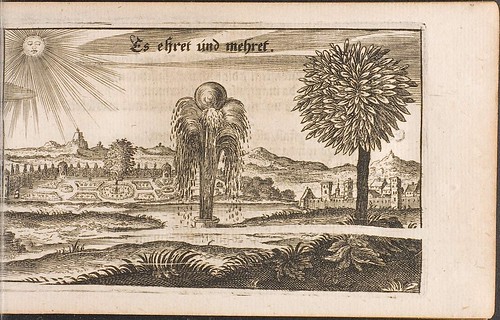
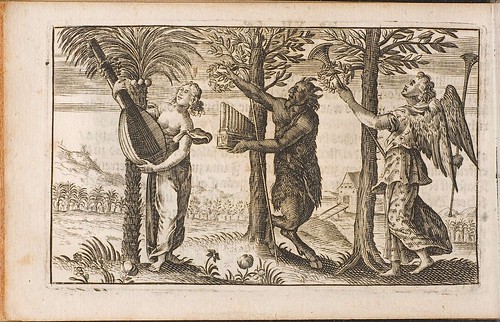
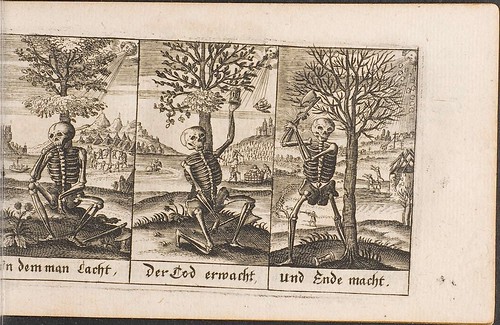
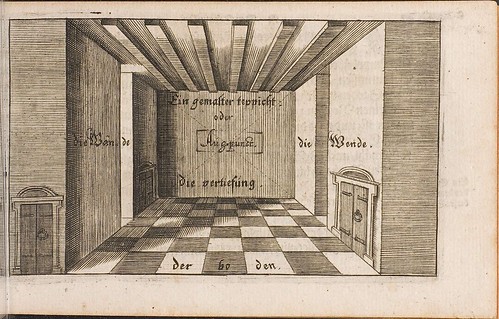

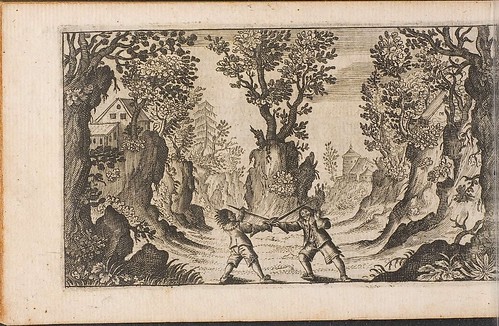
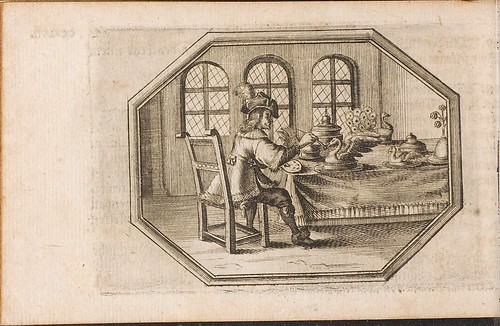





Even by the standards of the extravagant and allegorical excesses of the Baroque, which are much favoured as subject matter for this site, the 1646 'Frauenzimmer Gesprechspiele', by Georg Philipp Harsdörffer, is a very very weird book. Or, series of books, in fact.
Harsdörffer (1607-1658) was educated in law and philosophy and served as an assessor in the lower and middle courts of his home town of Nuremberg. In his youth he travelled extensively around Europe and his skill with foreign languages allowed him a sideline occupation in translation. He was also a prolific author, having published material that could fill fifty volumes - chiefly poetry - in his career.
He is regarded as one of the major writers (or perhaps, literary influences) of 17th century Germany and was a founding member of the Nuremberg literary society called the Shepherds of Pegnitz. The group had a complex set of values that was communicated primarily through Harsdörffer's publications. With a foundation in pastoralism, the group rejected the imitation of the ancients (an anti-Renaissance edge I suppose) and the authority of Aristotle; and instead, were advocates for a Germanising of literature and an overall theatrical aesthetic that favoured the synthesis of the various branches of the Arts.
If that's not sufficiently convoluted, these tenets were held to be expressed most honourably, or in the most edifying manner, through opera: Harsdörffer wrote at least one libretto and, together with the Shepherd Society's influence, the rise of German language opera was given something of a literary boost during the 17th century. Opera allowed the unity of poetic text, music, design and painting to achieve harmony out of the dissonance in the world.
The final Baroque trope that would find (visual) voice in the writings of Harsdörffer was the art of the literary conceit in which images steeped in symbolic meaning - in the manner of emblems and imprese* - were deployed to communicate to the observer a greater level of knowledge than could be expressed through language alone.
It's perhaps one of the most puzzling aspects of Baroque culture, this notion of a semiotic theory of metaphor, in which objects, forms and illustrations were processed and valued according to their hidden meanings. Whether natural or artificial, each entity might have a correspondence with another object or might symbolise abstract qualities like vices or virtues and in a literary sense, pictures made up of varying elements and layers of meaning could be further augmented with mottoes or epigrams or allegorical text by way of accompaniment.
Two other things worth noting - one relevant here and one not - are that with the Baroque abstract manner of perception, it's not surprising that people played around while crafting visual motifs in order to embed very obtuse labyrinths of allusion to dazzle, perplex and amuse the literati. That perception also has a resonance with the collection culture: having a wunderkammer filled with amazing objects was not just about creating a display museum. The objects were themselves symbols through which the collector was able to derive a more profound knowledge of the world.
'Frauenzimmer Gesprechspiele' (Playful Colloquies for the Ladies or Women's Room Conversational Games) is an eight volume work published through the 1640s. As best I can make out from the snips of commentary around, it attempts to record the philosophies of the Shepherds of Pegnitz, outline the social activities of the era and provide an analysis of emblems and instructions for creating them at home. In other words, it was something of a manual for Baroque aesthetics. The information was presented in the form of a dialogue between characters.
People could consult this series to learn how to have emblem parlour games in order to baffle their friends by sketching their own emblems and writing related verse. It's hard to explain why exactly, but I get the feeling that there was some level of irony in all this, that it was not an overly serious work and was meant, like the emblem games themselves, to be primarily a source of entertainment. I'm having trouble reaching for any contemporary analogies. Maybe it's like you do a university degree in fine arts for the purpose of drawing silly stick figures ... or something. And of course, it feels entirely appropriate that I'm having great difficulty wrapping my head around it.
Are these really emblems? I don't know.
By the time I'd collected the above images, finished searching for background information and written the preceding spiel, I discovered that the illustrations above come from Volume 6 of 'Frauenzimmer Gesprechspiele' and that a (later edition of a) second volume (Volume 2) is also online, from which the selection below was drawn. Both are available from Herzog August Bibliothek.
That first engraving below is a reworking of the famous 16th century painting by Giuseppe Arcimboldo, 'The Librarian'.
I'm off to have a shower to wash all this weirdness out of my system. Everything written in this post, more than usually, should be regarded as lacking in authority, despite my best efforts.
Update: See the later post, Heart for Art's Sake, for a more orthodox emblem book by Harsdörffer.
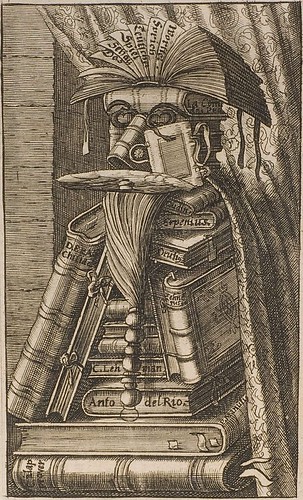
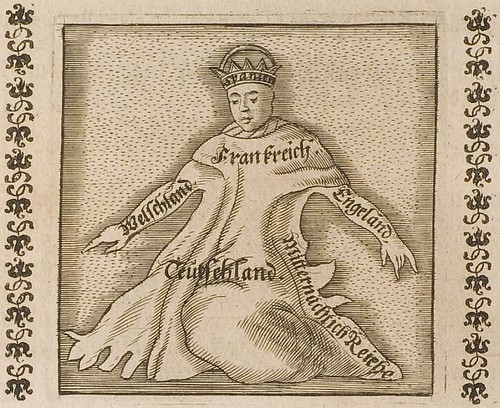
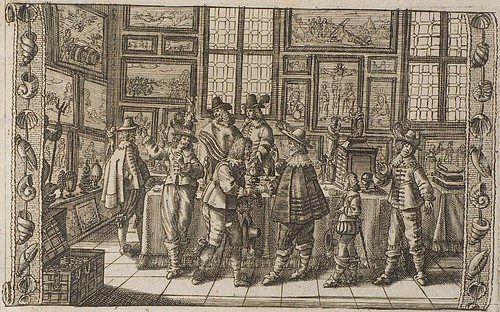




















6 comments :
"I'm off to have a shower to wash all this weirdness out of my system."
Surely not. If I don't leave the internet to bathe, you can't either. Especially not to wash out the weirdness.
I would guess that emblemata are still going strong (no doubt you've read about their Renaissance versions since there's a fair amount written about those) but now we'll both have to read that Westerhoff article.
Thank you great illustrations and books.
Perhaps this reference can also be of use: Frauenzimmer-Gesprächsspiele: Salonkultur zwischen Literatur und Gesellschaftsspiel, Festvortrag zur 97. Jahresversammlung der Gesellschaft der Bibliophilen e.V. am 9. Juni 1996 in Münster
Dollinger, Petra. - München : Gesellschaft der Bibliophilen, 1996. - 43 p., ill.
Dear peacay,
Frauenzimmer is literally "ladies room" but was used as "Her Lady´s Court" with all persons -including men- under the personally rule of his masters wife....
Many thanks for your work !
Ralf
Cheers!
The two quoted title translations were from two separate journal articles actually. I think both of them are not 'quite right': there are 'translations' and then there are conversions into regular english. Neither strike me as 'regular' (although that's subject to argument of course!). But the meaning is, nevertheless, quite clear anyway.
Thank you
Post a Comment
Comments are all moderated so don't waste your time spamming: they will never show up.
If you include ANY links that aren't pertinent to the blog post or discussion they will be deleted and a rash will break out in your underwear.
Also: please play the ball and not the person.
Note: only a member of this blog may post a comment.